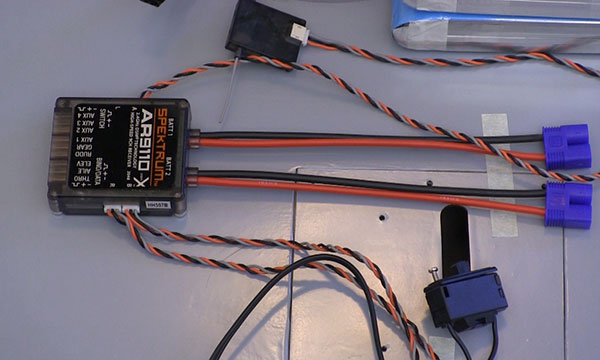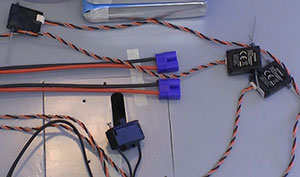



Adding redundant batteries to your planes just got a bunch easier.
Text, photos and video by Tom Hintz
Fight video by Clark Ponthier
Posted – 2-5-2016
There is precious little in the world of radio controlled flight that is cheap. As the cost of our models goes up so does the concern over “freak” malfunctions that can wipe that investment out. One of the bigger breakthroughs in the radio systems we use has been dual battery support for the receiver and servos. For some time, redundant battery systems were only available as add-ons to regular receivers and often at a substantial cost. But folks like Spektrum didn’t just sit around and watch, they developed purpose designed flight receivers that provide the security of dual batteries without the complexity and “birds nest wiring” of a separate add-on system. As I progressed in my giant scale planes I began using the Spektrum AR9110 PowerSafe™ 9 channel receiver and have never looked back.
The AR9110 PowerSafe™ is a full range aircraft DSMX, 9-channel receiver using both DSM2/DSMX modulation on the 2.4GHz band with a resolution of 2048. The AR9110 PowerSafe™ comes with three satellite receivers on 9”, 12” and 24” extensions with a plug for a fourth satellite. Combined with the dual path redundancy of Spektrum’s patented DuaLink® technology, if you place each of the satellites in a different location and at a different angle, each of them is exposed to a different view of the RF environment for a near bulletproof RF link in all conditions. The AR9110 PowerSafe™ receiver features a power bus designed to handle 6.0 to 10.0-volt power so you can use normal or high voltage servos to match the battery voltage. Spektrum managed to pack all this into a 1.86”-long by 1.58”-wide and 0.56”-tall package with an overall weight (including the satellite receivers and wiring) of just 2.1 oz!
The AR9110 PowerSafe™ receiver comes with twin 16AWG battery input leads with EC3™ connectors though I changed those to Deans plugs to be compatible with my existing batteries and charging systems. A “soft switch” comes with the AR9110 PowerSafe™ receiver that is designed so that it can only fail to the ON position.
Three satellite receivers increases radio
safety.
The AR9110 PowerSafe™ receiver is compatible with all Spektrum™ and JR® full-range DSM2® and DSMX® radio systems. You get even more security because the AR9110 PowerSafe™ receiver features SmartSafe™ technology plus the ability to preset failsafe points. In SmartSafe™ mode if signal is lost the throttle is driven to its preset, usually low throttle and all other channels remain at their last position before signal loss. The ability to preset failsafe points lets you send all of the channels to their neutral point, throttle low or even put a small turn into the failsafes to keep the model in the area if signal is lost for an extended amount of time.
Actually getting the AR9110 PowerSafe™ receiver into your plane is easy because of its small overall size and because you don’t have to wire in an additional after-market battery system. I like the options that the overall size and weight of the AR9110 PowerSafe™ receiver make possible. Even on the more confining fuselages finding a good spot to mount the AR9110 PowerSafe™ receiver is not difficult. Because it is so light you can mount the AR9110 PowerSafe™ receiver just about anywhere and use the placement of other components – like the batteries – to get the CG (center of gravity) right and reduce the amount of extra weight needed – if any.
I put the AR9110 PowerSafe™ receiver in my RedwingRC 50cc YAK 55 and the Top-Flite Giant Scale P47 Razorback I am currently building also uses this receiver. The RedwingRC 50cc YAK 55 has five HiTec HS7954SH, high voltage servos each cranking out over 400 in oz of torque and the AR9110 PowerSafe™ receiver makes sure none of them gets less power than they need even when I jam the sticks in the corners.
But more important than the sheer power to the servos is the safety the dual batteries brings to my planes and that cannot be overstated. One of the reasons I use twin 5000mAh batteries is the peace of mind I get from knowing that one pack can die altogether and the AR9110 PowerSafe™ receiver will simply isolate that pack and continue to power everything off the other battery. With such large packs this can happen on the first flight of the day or the last and I have plenty of power to get an expensive plane back on the ground normally.
Certainly the AR9110 PowerSafe™ receiver is lighter than many add on redundant battery systems and I love adding light to any of my planes. But it is the peace of mind that I get knowing that the AR9110 PowerSafe™ receiver is in my planes protecting a sizable investment.
The AR9110 PowerSafe™ receiver is a must-have piece of equipment in todays giant scale planes as well as many other mid to large planes. The small physical size and its wide ranging compatibility with battery voltages makes installing it in your planes simple.
The AR9110 PowerSafe™ receiver has a street price of $199.99 (2-5-2016) which is less than many of the add-on systems that you add to a separate receiver. It’s not often that we can improve performance and safety in our planes and save money at the same time. Spektrum has been one of the leading radio manufacturers for years and the AR9110 PowerSafe™ receiver shows they are paying attention to the people who buy and fly their products. I can’t imagine a good reason to not equip all of my future giant scale planes with the AR9110 PowerSafe™ receiver.
Visit the Spektrum AR9110 PowerSafe™ receiver web page – Click Here
Have a comment on this review? –Email Me!